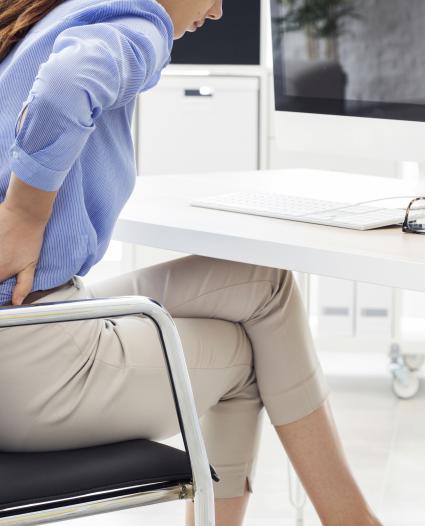Workplace MSD Hazards
A workplace hazard is a potential source of harm to a worker. The harm in this case is the potential development of a Musculoskeletal Disorder (MSD) such as shoulder pain. MSD hazards typically appear when the way that work is organized brings the worker and the work environment together.
Basic MSD Hazards
- Awkward postures
- High forces exerted by workers
- High repetition, static postures (and other time-related issues)
- Vibration
- Local contact stress
- Temperature
Combinations of MSD Hazards
At work, MSD hazards typically occur in combination. For example:
- Long durations spent in an awkward posture (i.e. shoulder postures when completing overhead work)
- Forceful exertions on a frequent basis
- Work may require a high force to be exerted in an awkward posture with a vibrating tool
- Hazard recognition is the first step in the RACE process. If an MSD hazard is identified and consensus is achieved by management and workers that a practical control is available, it should be implemented to eliminate or control the hazard. More in-depth analysis through
- MSD risk assessment is required if the control does not eliminate the MSD hazard.
When multiple MSD hazards are present in the same task, it can be difficult to know how the interaction impacts overall MSD risk. Observational and comprehensive risk assessment methods use scoring systems or equations to assess the combined effect of MSD hazards.
Learn More about MSD Hazards
Click on each card to learn more about these primary MSD hazards.
Posture
Posture is the position of the body and its joints. Some postures are stronger and healthier than others; sometimes called neutral postures. An awkward posture is one where the joint is weaker or more likely to fatigue or become injured. These awkward postures, over time, can lead to increased risk of developing an MSD.
Force
Examples of force include the force exerted on a box during lifting or the grip force to hold a hand tool. If the force exerted is high, the muscle around the joints must contract forcefully and are likely to fatigue. The high forces, over time, can injure nerves or other tissues.
Repetition/Time
Repetition describes how the postures and forces change over time. On this page you will find descriptions of different repetition/time related concepts including repetition, static/dynamic postures, duration, duty cycle, how to predict acceptable efforts for repetitive tasks, breaks/pauses/micropauses, and rest allowance.
Additional MSD Hazards
Vibration
A worker may be exposed to vibration in two main ways:
- At the hands, for example by a vibrating hand tool such as a drill. This is called Hand Arm Vibration (HAV)
- Through the feet if standing, or through the buttocks if sitting. This is called Whole Body Vibration (WBV)
Local Contact Stress
A tool that digs into a worker’s hand or the pressure on the kneecap when kneeling both create local contact stresses. These contact stresses can, over time, injure the skin or cause blisters or injure the muscle, ligament or bone underneath the skin.
Cold
There is some evidence that working in cold temperatures is associated with an increased risk of developing MSD. Different mechanisms have been proposed. However, working in the cold often requires a worker to wear a glove and gloves can greatly increase the effort required to grip objects.
Influential Factors
Psychosocial Hazards
Psychosocial factors include a mix of jobs, work environments and organizational characteristics. They include factors such as low job control, low decision latitude, conflicting job demands, or low supervisor support.
Work Organization
Work Organization is defined as the way work is structured, distributed, processed and supervised. When it comes to Identifying an MSD hazard or performing a Risk Assessment, it is important to know how the job or how the work is organized. Work organization may minimize or magnify the effects of MSD hazards.
Common Workplace Task Specific Hazards
The hazards of force, posture, repetition/time, vibration and cold are independent of job, task or sector. However, common combinations of these hazards are seen in different types of task and sectors. For example, using a power hand tool has hazards of force and vibration. These common task specific hazards also have controls that are similar across sectors.
Sitting and Standing
Many jobs require sitting, standing or some of both. Workers in retail may stand without taking more than a few steps for an entire shift. A worker in a hydro-generating station may sit and monitor multiple visual displays and only stand up occasionally in an entire shift. Neither of these situations are desirable.
Information Technology/Computer Work
Working with computers is part of most jobs and many jobs involve working with these devices for the majority of the time. Work using computers involves potential concerns of sitting or standing for prolonged periods, looking continuously at visual displays (monitors) and using input devices such as a keyboard or mouse.
Manual Materials Handling (MMH)
Manual Materials Handling (MMH) involves moving objects or materials. It includes lifting and lowering; pushing and pulling and carrying.
Client/Patient Handling
Moving and transferring clients/patients is a highly demanding physical activity. These activities can be seen in Acute Care Hospitals, Residential Care facilities, Nursing Homes and in home care settings.
Overhead Work
Overhead work creates high loads on the shoulders. During overhead work, shoulder muscles fatigue quickly. It has been shown that the fatigue of some of these muscles allows the head of the humerus bone to trap key muscles and tendons. Over time this can cause pain and injury to the shoulders.
Power Tools
Power tools can expose the user to high vibration, high forces to hold and position the tool or part, kickback or torque reaction as well as awkward postures to position the power tool.

Want to search the resource library?
Find all the available resources on the MSD prevention website, including posters, videos, and links to relevant websites.

